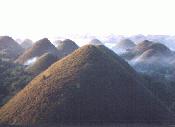
the Philippines

An introduction to the geography, economy and people of the Philippines.
Philippine Facts
The Philippines has a tropical monsoon climate, which is hot, humid and wet. The capital city of the Philippines is Manila. The land area of the Philippines is about 300,000 km² and its coastline is 36,289 km long. Natural disasters occur here frequently in the forms of landslides, active volcanoes, earthquakes and tsunamis. Forests account for about 46% of the land in the Philippines. Major natural resources are timber, petroleum, nickel, cobalt, silver, gold, salt and copper. The islands here are mountainous islands with narrow to extensive coastal lowlands. Mount Apo is the highest point on the Philippines, about 2954m tall. The largest islands in the Philippines are Luzon and Mindanao. A famous tourist attraction here is the Chocolate Hills (below) — limestone moulds which turn brown during the dry season (December).

The Philippines was granted independence on the 4th of July 1946 from the United States. The Philippines is a republic. The head of government is President Gloria Macapagal-Arroyo who is also the head of state. The Cabinet is appointed by the president with the consent of the Commission of Appointments. The legislative branch of the Philippines consists of a Congress consisting of the Senate (Senado) and the Judicial branch consists of the Supreme Court whose justices are appointed for four-year terms by the president on the recommendation of the Judicial and Bar council.
In 1998 the Philippine economy - a mixture of agriculture, light industry, and supporting services - deteriorated as a result of the spillover from the Asian financial crisis and poor weather conditions. Growth fell to about -0.5% in 1998 from 5% in 1997, but recovered to 2.9% in 1999. The government has promised to continue its economic reforms to help the Philippines match the pace of development in the newly industrialised countries of East Asia. The strategy includes improving infrastructure, overhauling the tax system to bolster government revenues and moving toward further deregulation and privatisation of the economy.
The population of the Philippines is about 81,159,644 and the growth rate is about 2.1%. Life expectancy in the Philippines is around 67.5 years at birth. The Philippines is mainly Christianised Malays (91.5%) and Malay-Muslims (4%). Chinese (1.5%) and other races (3%) make up the remainder of the population. People in the Philippines are Roman Catholics (83%), Protestants (9%), Muslims (5%), Buddhists or follow other beliefs. Languages commonly spoken in the Philippines are Filipino and English. The literacy of the total population is 94.6%.
Ideally, this website should be viewed using Internet Explorer 5.